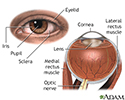Choroidal dystrophies
Choroideremia; Gyrate atrophy; Central areolar choroidal dystrophy
Choroidal dystrophies are eye disorders that involve a layer of blood vessels called the choroid. These vessels are between the sclera (the white of the eye) and retina (the black of the eye).
In most cases, a choroidal dystrophy is due to an abnormal gene, which is passed down through families. It most often affects males, starting in childhood.
The first symptoms are peripheral vision loss and vision loss at night. An eye doctor who specializes in the retina (back of the eye) can diagnose this disorder.
Exams and Tests
The following tests may be needed to diagnose the condition:
Treatment
Clinical trials have been underway to try to slow the disease progression by injecting a form of the missing genetic material under the retina.
References
Freund KB, Sarraf D, Mieler WF, Yannuzzi LA. Hereditary chorioretinal dystrophies. In: Freund KB, Sarraf D, Mieler WF, Yannuzzi LA, eds. The Retinal Atlas. 2nd ed. Philadelphia, PA: Elsevier; 2017:chap 2.
Fleckenstein M, Schmitz-Valckenberg S, Holz FG. Autofluorescence imaging. In: Schachat AP, Sadda SVR, Hinton DR, Wilkinson CP, Wiedemann P, eds. Ryan's Retina. 7th ed. Philadelphia, PA: Elsevier; 2023:chap 5.
Lam BL, Davis JL, Gregori NZ. Choroideremia gene therapy. Int Ophthalmol Clin. 2021;61(4):185-193. PMID: 34584056 pubmed.ncbi.nlm.nih.gov/34584056/.
Rahmani S, Schmitt M, Stepien KE. Inherited retinal diseases. In: Yanoff M, Duker JS, eds. Ophthalmology. 6th ed. Philadelphia, PA: Elsevier; 2023:chap 6.13.
Yanoff M, Sassani JW. Uvea. In: Yanoff M, Sassani JW, eds. Ocular Pathology. 8th ed. Philadelphia, PA: Elsevier; 2020:chap 9.
Review Date: 11/8/2023






